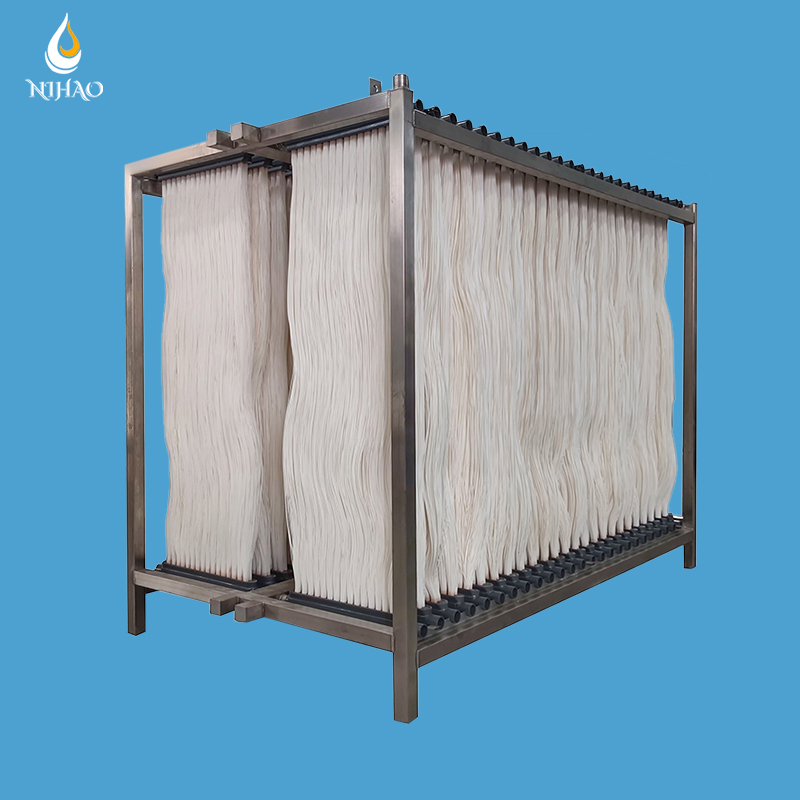 +86-15267462807
+86-15267462807
MBR membrane (Membrane Bio-Reactor) is an efficient technology widely used in the field of water treatment.
MBR membrane uses membrane separation to intercept and separate solid substances in sewage. It uses membrane components to replace the secondary sedimentation tank in the traditional biological treatment process, maintains a high concentration of activated sludge in the bioreactor, and fully degrades and removes pollutants in the bioreactor. The pore size of MBR membrane is small (0.05~0.4μm), which can effectively intercept suspended solids, bacteria and macromolecular organic matter to ensure stable effluent quality. The hollow fiber design allows for a high surface area to volume ratio, which increases the efficiency of the membrane filtration process.

MBR membrane has been widely used in many industries due to its high efficiency, stability and multifunctionality, as follows:
Municipal sewage treatment: MBR technology is widely used in urban sewage treatment plants to treat domestic sewage. It can effectively remove suspended solids, organic matter and pathogens in sewage, and the effluent water quality is clean, suitable for direct discharge or reuse.
Industrial wastewater treatment: MBR technology is particularly suitable for treating high-concentration, toxic, and difficult-to-degrade industrial wastewater, such as wastewater from the chemical, pharmaceutical, food processing, textile, papermaking, leather, synthetic fatty acid and other industries. These wastewaters often contain a large amount of organic matter, heavy metals, grease and other pollutants. MBR technology can effectively remove pollutants and purify water quality.
Electroplating wastewater treatment: Electroplating wastewater contains heavy metals and harmful chemicals. MBR technology can effectively remove these pollutants and meet strict emission standards.
Semiconductor and electronics industry wastewater treatment: Wastewater generated during semiconductor manufacturing and electronic product production contains particulates, heavy metals and other harmful substances. MBR technology can ensure that the effluent water quality meets strict environmental protection requirements.
Oil and gas industry: In the process of oil refining and natural gas processing, MBR technology can treat wastewater containing oil, organic matter and sulfide to reduce the impact on the environment.
Agricultural and food processing wastewater treatment: Wastewater generated by the agricultural and food processing industries is usually rich in organic matter and nutrients. MBR technology can effectively remove these pollutants and help recycle water resources.
Hospital and medical wastewater treatment: Medical wastewater may contain pathogens, drug residues and other harmful substances. MBR technology can ensure the thorough purification of these wastewaters and prevent the spread of diseases.
Rainwater treatment and reuse: MBR technology is also used to collect and treat urban rainwater so that it can be reused for flushing toilets, irrigation and other purposes, reducing dependence on fresh water.
Seawater desalination pretreatment: In the process of seawater desalination, MBR technology can be used as a pretreatment step to remove suspended matter and organic matter in seawater and protect the subsequent reverse osmosis membrane from damage.
Mineral mining wastewater treatment: Wastewater generated during mineral mining and processing contains heavy metals and toxic chemicals. MBR technology can effectively remove these pollutants and protect the environment.
Good effluent water quality: MBR membrane can efficiently intercept suspended matter, bacteria and macromolecular organic matter to ensure clean effluent water quality. It can be directly used for industrial cooling, green irrigation, etc. to achieve water resource recycling.
Small footprint: The MBR system is compact and does not require a secondary sedimentation tank, which reduces the footprint and is particularly suitable for transformation and upgrading and space-constrained scenarios.
Convenient operation and management: The MBR system can achieve fully automated operation, easy operation, and reduced labor costs.
Strong adaptability: The MBR system can adapt to water quality fluctuations, has strong buffering capacity, and is suitable for wastewater treatment under various water quality conditions.
Long sludge age operation: The MBR system can achieve long sludge age operation (20~40 days), reduce the amount of residual sludge, and reduce the cost of sludge treatment.